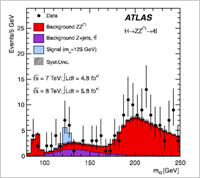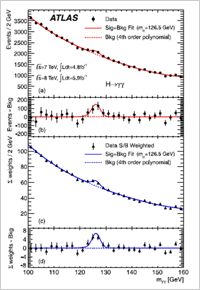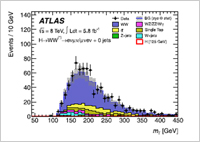Enlarge Image Figure 2 Caption : The distribution of the invariant mass of diphoton candidates. The inclusive sample is shown in (a) and a weighted version in (c). The residuals of the data and weighted data with respect to the respective background component are displayed in (b) and (d).
Enlarge Image Figure 3 Caption : Transverse mass distribution in the WW control region for the 0-jet channel. The eμ and μe final states are combined. The hashed area indicates the total uncertainty on the background prediction. The expected signal for mH = 125 GeV is negligible and therefore not visible.
Enlarge Image
Observation of a new particle in the search for the Standard Model Higgs boson
The Standard Model (SM) Higgs boson has been searched for more than forty years, which gives mass to massive elementary particles in the standard model of high energy physics.
The nature of the SM Higgs boson has been well understood but the mass value cannot be predicted and the past experiments have not had enough energy to produce the boson.
Recently a new particle has been found with the ATLAS and the CMS detectors at the Large Hadron Collider (LHC). Both are huge groups and the ATLAS has more than three thousands people. Dr. I. Nakano (Graduate School of Natural Science and Technology, Department of Physics- Faculty of Science, and Research Center of Quantum Universe-Faculty of Science of Okayama University) is one of the members.
The LHC is 7-8(14 in 2019)-Tev proton-proton collider.and the ATLAS detector consists of Inner detector, Calorimeter and Muon detector. Produced particle energy and momentum are measured by the detectors and the invariant mass is reconstructed.
The new particle was seen in the invariant mass of four leptons (Fig. 1) and two gammas (Fig. 2). The mass was 126.0±0.4 (stat)±0.4 (sys) GeV.
The transverse mass for WW decays (Fig. 3) does not show the resonance peak but is consistent with the expected transverse mass from Higgs mass =125 GeV.
Therefore, these observations are compatible with the production and decay of the SM Higgs boson. We need more investigation to confirm the new particle as the SM Higgs.
If the new particle is the SM Higgs, we understand the origin of mass. In addition to it we start to complete the SM and to go further understanding of the elementary particle physics and our Universe.
Reference:
・ Authors : G. Aad et al. (ATLAS collaboration)
・ Title of original paper : Observation of a new particle in the search for the Standard Model Higgs boson with the ATLAS detector at the LHC
・ Journal, volume, pages and year : Physics Letters B716, 1(2012).
・ Digital Object Identifier (DOI) :: 10.1016/j.physletb.2012.08.020



